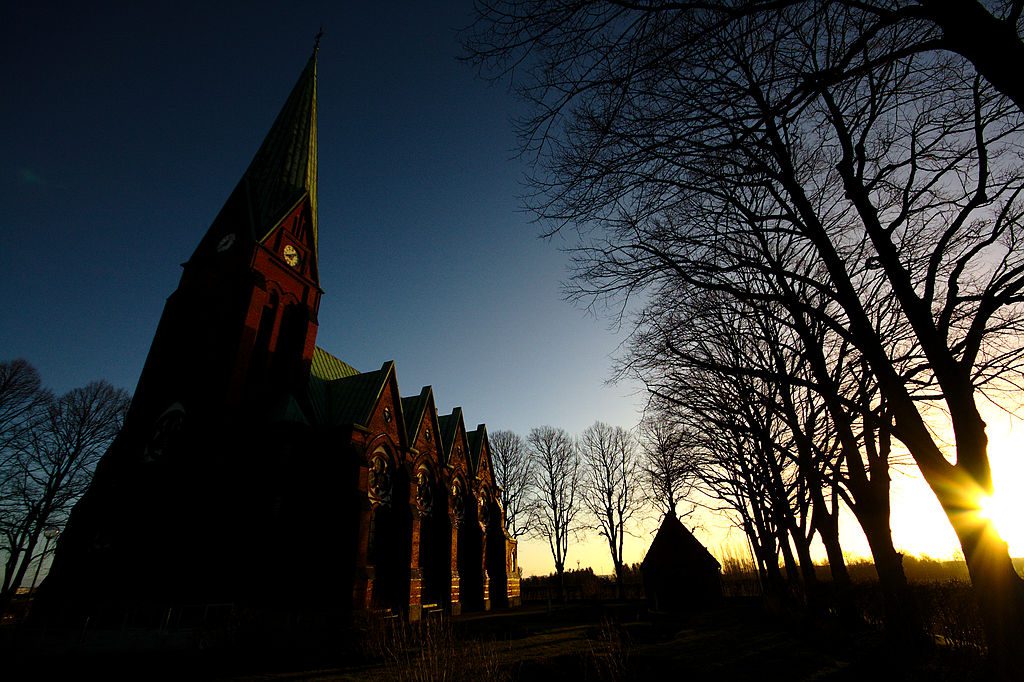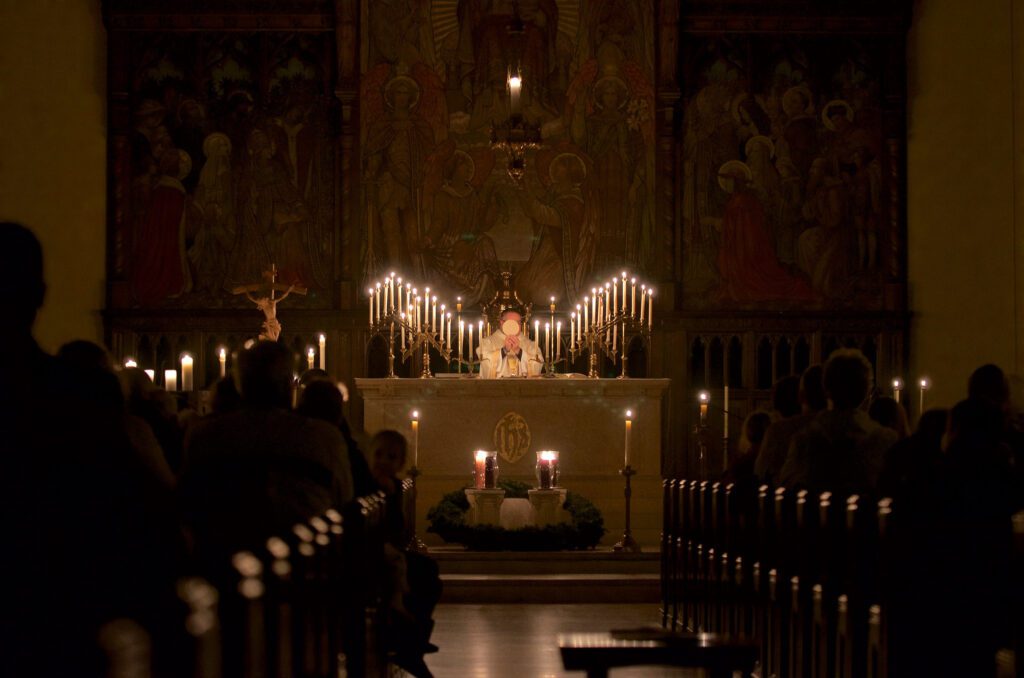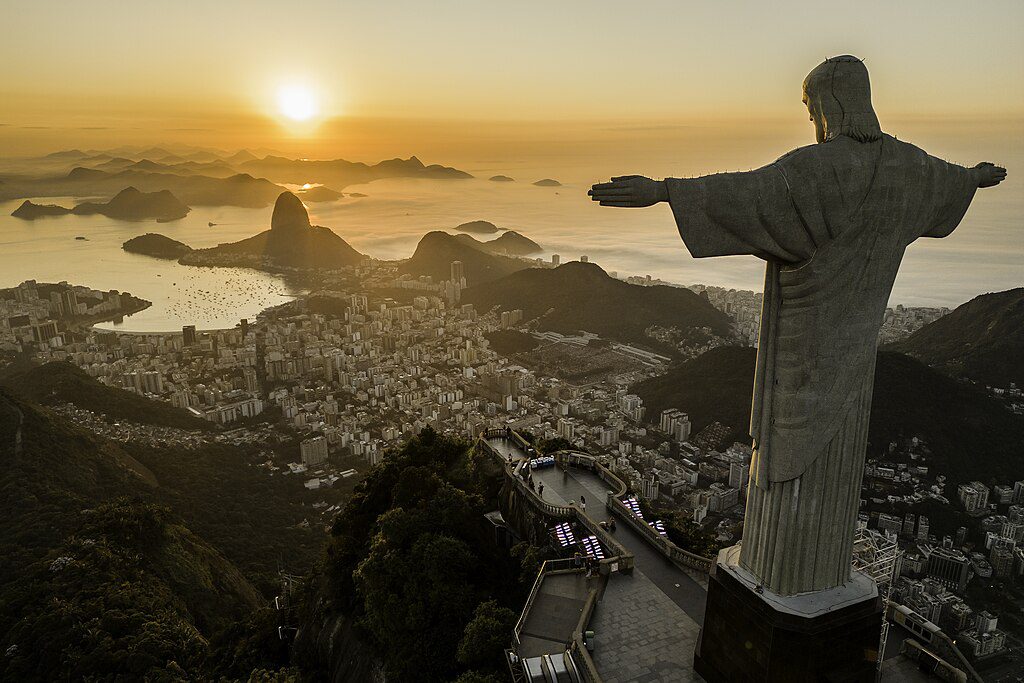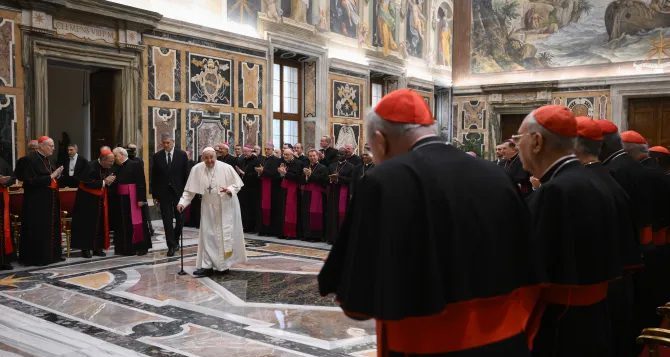Children often ask me about the candles on the altar.
Why are they there?
One basic explanation is an appeal to fittingness. Imagine a fancy dinner, a wedding feast. It’s natural to solemnize the occasion with candles on the tables. The Holy Sacrifice of the Mass is the greatest of nuptial feasts, so it makes sense we burn candles.
There’s also a prosaic explanation. The priest needs to see the text in the missal. In the days before electric light, stone church buildings without large, clear windows to admit natural light remained dim even on the brightest days. I know this because when on a few occasions the power has gone out during Mass, I needed a server to bring a candle to the missal.
There’s also a more subtle explanation for the candles, one that goes to the very source of religion and human nature.
Natural Light and Solar Religion
On the natural level, light has shaped human existence from the beginning. The cycle of the sun affects our growing season, when we sleep, how we see, and even regulates our hormone levels. Ancient man acknowledged the importance of light by inventing solar deities. The Egyptians had Aten, the Greeks Apollo, the Incans Inti, the Persians Mithra, and so on.
The Israelites refused to deify the sun, but they revered light. Hanukkah, for instance, celebrates the restoration of light in the temple. Josephus, in the Antiquities, writes, “We celebrate this festival, and we call it Lights.” Other festivals on the Jewish calendar are connected to the sun and its attendant cycles of planting and harvesting. These religious rituals didn’t worship the sun but, rather, apprehended light as a sensible sign of God’s glorious presence—what the Israelite’s called his shekinah. As Paul Claudel comments, “It is a light, infinitely more delicate than all the sensory organs.”
Light has shaped human existence from the beginning.
The Church’s liturgical calendar is also sensitive to the movement of the sun in the sky. Harvest feasts, such as rogation days, are only the beginning of the nuances in our calendar. The nativity of St. John the Baptist aligns with the summer solstice. From his birth, the daylight of the one-who-must-decrease grows shorter. St. Lucy, a virgin martyr who sacrificed her vision for love of her Savior, was blinded and martyred on December 13, near the winter solstice and darkest day of the year. Christmas then occasions an increase of sunlight. The days grow brighter into and through the Easter season, punctuated by the great celebration of light that is Epiphany. Donald DeMarco recently wrote a lovely essay for Adoremus about Candlemas, which falls halfway through winter. He points out the poetic implications of candles as light sources that gain strength with the sun.
The metaphor of light is brought to fullness in Christ the Rising Sun. Our Lord gives away his life in eclipsed darkness at the Cross and, three days later, rises in a blinding flash of light. Forty days later he ascends to the New Jerusalem, which is lit by the glory of his presence. This heavenly city is arriving in ever-increasing redemptive luminosity until some day, when we least expect, the Light of the World will return like the sun bursting over the eastern horizon, light radiating and spilling into every dark valley and shadowed corner.
For this reason, Christians have always preferred to pray facing east, watching and waiting for the Light. They took this orientation to the Rising Sun extremely seriously. The traditional method to position new churches was along the solar axis. Architects marked out the position of the rising sun on the feast day of the patron saint for that particular church. This solar position then became “true east” for the building. For example, on the feast of St. Luke, at dawn the sun would rise directly before the altar at St. Luke’s parish. The people of God literally faced the Light.

Christians have always preferred to pray facing east, watching and waiting for the Light. They took this orientation to the Rising Sun extremely seriously. The traditional method to position new churches was along the solar axis. Architects marked out the position of the rising sun on the feast day of the patron saint for that particular church. This solar position then became “true east” for the building. For example, on the feast of St. Luke, at dawn the sun would rise directly before the altar at St. Luke’s parish. The people of God literally faced the Light. Image Source: AB/Wikimedia
Supernatural Light
If it’s natural for mankind to look up with awe at the sun, acknowledge the truth of our dependence on it, and endow it with religious significance, it’s even more true that the sun’s power is entirely dependent on Christ who is the Light.
We’ve noted that the sun affects our liturgical calendar. It’s more accurate, though, to say that the liturgical calendar dictates the cycle of the sun. The spiritual reality underpinning the cosmos is more necessary and fundamental than sensible phenomena. Creation is an occasion of wide-eyed wonder, but it’s a reflection. In a mysterious way, by some secret ladder, heaven and earth are joined in an analogy of being. The two are not the same but they also aren’t different. In the hierarchy, the natural always leads to the supernatural and depends upon it.
This primacy of the spiritual realm is clear from the first chapter of Genesis. God creates light before he creates the sun. When the liturgy orients itself to the sun, it is our Lord, the uncreated supernatural Light who is the object of our adoration. Through his priesthood we also adore the luminous Trinity.
The sun is the symbol. Christ is the light. The Mass is a poetic communication of Light, the procession of lumen de lumine which illumines the human soul. As Claudel writes, “Speaking of the happiness of the purified soul, compare it to a light, and not to all light, but precisely to that of the morning which crosses its fires with the light whose name above the deserts is: O Oriens.” He goes on to write that divine light directs us towards “the happiness of being constituted at every moment at the source.”
This primacy of the spiritual realm is clear from the first chapter of Genesis.
Christ the Light is a correction of and fulfillment of the ancient solar religions. In particular, he unveils the Old Covenant. The Light was always there. It burned white-hot at the burning bush and in the column of fire that led the Twelve Tribes. It lit the face of Moses so powerfully that it disfigured him and he covered his countenance. It descended onto the holy of holies when the tabernacle was completed and, again, was veiled under ritual and symbol.
The Light was always there even if the people didn’t see it. It never ceased to shine. Sacrifices of incense as physical phenomena of captured, congealed sunlight were burned by the priests on a regular basis. The high priest vested in a white robe, an impressive display that gestured towards divine light in an era when clothing was difficult to keep bright and clean. Over his robe, he wore vestments of many colors embedded with gemstones, reminiscent of God’s rainbow of promise. The vestments descend from Joseph’s coat of many colors, a garment of light bent through a prism.
This is the dense symbolic imagery into which Christ is born. On the night he arrives, the sky flashes with his glory. In midnight, the Light enters his world. St. John sums it up, “In the beginning was the Word. In him was life, and that life was the light of all mankind.”
Throughout his Gospel, St. John recognizes Christ’s glory contrasted with lack of light in those who fail to recognize his divinity. Nicodemus departs by night, Judas runs into the night to betray his Lord, and the Magdalene arrives at her Lord’s tomb in pre-dawn. St. John the Baptist, on the other hand, testifies to the light, the miracles of Our Lord are “signs” pointing to heavenly glory, and the crucifixion itself is, ironically, the fullest revelation of Christ’s glorious light. This is where he is crowned with thorns, a halo formed in conjunction with suffering.
To those without eyes to see, the light of Christ cannot be apprehended. Our Lord, however, desires that we would all see, so throughout his ministry he reveals the deeper meaning of Jewish liturgical practices. In doing so, he reveals the light at the heart of the Old Law and how, with Christ as its fulfillment, it will blaze up into a burning sun. At Cana, he transforms ritual water for purification into new wine. At his baptism, he steps into the old waters of repentance and elevates them into sacrament. He attends the Feast of Tabernacles and there declares himself the Light of the World.
The Feast of Tabernacles was a spectacle of light. During the eight feast days, the temple gates were left open so the faithful could gather for the ritual lighting of four lamps. Each lamp was mounted on a stand over 70-feet tall. Each of the four massive golden bowls was filled with oil and lit by the priests. Once burning, they were said to illuminate every courtyard in Jerusalem. It would have been immensely impressive to the ancient eye, unaccustomed as it was to artificial light of that magnitude.
This is when Christ makes his announcement: “I am the Light of the World.” He is greater even than the dazzling religious spectacle. He is the fulfillment, the Messiah. This is made crystal clear in the context of the reading from Zechariah that was prayed during Tabernacles: “On that day there will be neither sunlight nor cold, frosty darkness. It will be a unique day—a day known only to the Lord—with no distinction between day and night. When evening comes, there will be light.”

The Holy Sacrifice of the Mass is a liturgy of light because light is a symbol of great poetic power with which our Lord specifically identifies. But not only are candles poetic instances of light, not only are they practically suited to illuminating text, but they, too, are part of the sacrifice. St. Anselm teaches about candles that the wax is the flesh of Our Lord, the wick his soul, and the flame his divinity. As the candles burn, the wax is consumed. The candle visibly diminishes as it is sacrificed. The candles, like other elements at the heart of the Mass, are a gift of the Light to the Father. Image Source: AB/Jeff Geerling on Flickr
The Mass and Light as Sacrifice
The Holy Sacrifice of the Mass is a liturgy of light because light is a symbol of great poetic power with which our Lord specifically identifies. It’s helpful to our devotion to be cognizant of these symbols and think of our Lord under his divine title Light of the World.
I want to make an even more incisive point, though. Not only is the Mass a celebration of light as poetic metaphor, but the Mass is actually the sacrifice of light. Light is a rare resource, particularly before electric light bulbs. Offering our Heavenly Father the gift of light is a precious oblation.
Thus, the burning of incense at every Solemn Mass: “incense is a piece of crystalized sunshine that we immolate and consume in fire at the altar. It is a sacrifice of light that visibly rises to our Father.
Like priests of the old covenant, a Catholic priest is clothed in vestments of colored light not only as a visual symbol of light but also to eliminate his personality from divine worship. The priest temporarily sacrifices his identity as an individual in order to step into a new identity. He is a single ray of light sacramentally joined to the Source, flooded by and even overwhelmed by divine glory.
Incense is a piece of crystalized sunshine that we immolate and consume in fire at the altar. It is a sacrifice of light that visibly rises to our Father.
Returning to the candles on the altar. Not only are they poetic instances of light, not only are they practically suited to illuminating text, but they, too, are part of the sacrifice. St. Anselm teaches about candles that the wax is the flesh of Our Lord, the wick his soul, and the flame his divinity. As the candles burn, the wax is consumed. The candle visibly diminishes as it is sacrificed. The candles, like other elements at the heart of the Mass, are a gift of the Light to the Father.
Note that the candles are meant to be seven total, a number for the divine perfection of the Light. To this day, when a bishop celebrates the Mass, the seventh is placed on the altar and lit. At Mass celebrated by a priest, however, there are only six candles. Where is the seventh? It’s still there. It is transfigured into the altar crucifix. The crucifix, the perfect sacrifice, is luminous with glory.
Not only is the crucified Christ present in the Holy Sacrifice of the Mass, but so also is the resurrected Christ. Easter is there, too. The Light of the World is the sacrifice. Remember, the Light came into the world but the world knew him not.
Still, he shines.
The Light is redemptive, re-making the world by the power of divine glory, revealing the luminous heart of God. The Mass, as sacrifice, is our celebration of the Light, for it is in his Passion and Resurrection that he shines brightest. Even more, the Mass stirs embers within our individual souls. Grace is a consuming fire. United to Christ in his sacrifice, we too will shine.


